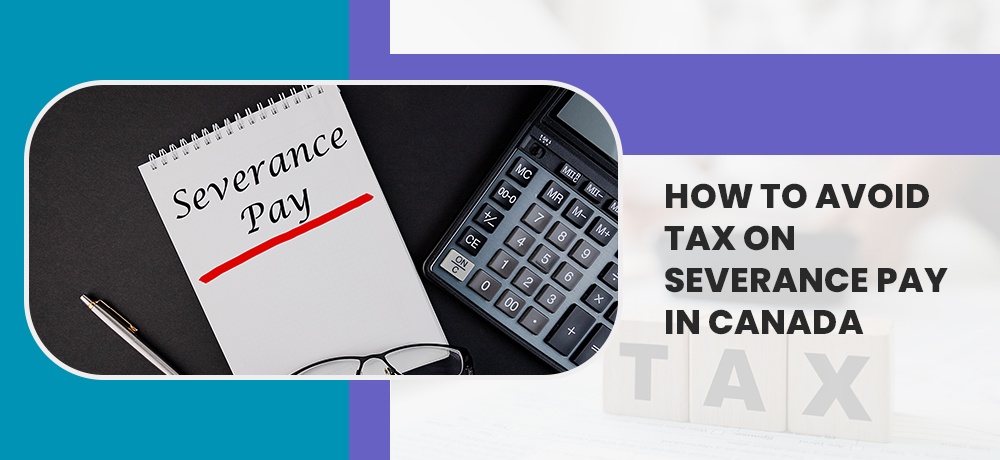How to avoid tax on severance pay in Canada

Find out how you can reduce the tax payable on a severance payment, and what happens when receiving a severance while transitioning to retirement.
Tax on severance pay in Canada
If you receive a large severance payment from your employer, the tax payable can be significant. A long-time employee who receives a 12-month severance payment late in the calendar year, for example, can end up with two years worth of income in a single year. For many employees, this may be the year they have the highest tax bracket and pay the most tax in their entire career.
Some employers offer a severance as a salary continuance. This means your salary continues to be paid for a certain period of time. Many employers prefer to pay a lump sum payment. Some employers will be willing to defer the payment to a future calendar year or pay a large severance over multiple years. An employment lawyer can help you assess your entitlement and negotiate terms before you agree to sign off on a severance offer.
Taxes on lump sum severance pay in Canada
In the case of a lump sum severance late in the calendar year, asking your employer to defer the payment to January may result in less combined tax.
As an example, an employee earning $75,000 of salary in British Columbia may pay about $14,000 of income tax. If they have a $75,000 salary and a $75,000 severance payment all in one year, they may pay nearly $41,000 of tax. If the $150,000 was split between two separate years, it would result in about $28,000 of tax, or around $13,000 of tax savings.
Consider RRSP contributions
A common tax reduction strategy with a severance is to contribute to a registered retirement savings plan (RRSP). An employee with a lot of accumulated RRSP room may be able to deposit some or all of their severance on a pre-tax basis. An employer can be instructed to deposit a severance directly to an RRSP.
If you receive the payment in cash first with income tax withheld, and then contribute to an RRSP, the drawback is that you will have less after-tax cash to make the contribution. You must then wait for a tax refund as well.
A long-time employee may be able to take advantage of an eligible retiring allowance if they worked for their employer in 1995 or earlier. This may allow extra RRSP contributions over and above an employee’s regular RRSP room.
According to Canada Revenue Agency, the eligible part of the retiring allowance is:
- $2,000 for each year or part-year of service before 1996 in which you were employed by the employer.
- An additional $1,500 for each year or part of year of service before 1989 in which you had earned no pension or DPSP (deferred profit sharing plan) benefit from employer contributions that either vested in you at the time of payment or that were previously paid to you.
Receiving severance and retiring
You may ask if you can receive a severance payment and retire—and presumably begin your pension—at the same time. A severance is a payment in recognition of the termination of your employment. An unreduced pension, or any pension for that matter, is a separate entitlement based on your pension plan membership and past contributions.
One consideration that may apply to others, if not to you, is that an employee on salary continuance may continue to contribute to their pension plan. This could boost the pension entitlement or allow you to earn an unreduced pension if you are close to meeting your age or service factors based on the pension formula.
What about CPP and OAS?
You may ask about continuing to contribute to the Canada Pension Plan (CPP) or Old Age Security (OAS).
CPP is a contributory pension where your contributions determine your future pension, just like your defined benefit pension at work. You may well be entitled to the maximum retirement pension if you have contributed for most of your adult life. You may also have years when you had children under the age of 7 that can be dropped out to maximize your pension (the so-called child rearing provision). You can confirm with Service Canada. However, you cannot elect to make optional CPP contributions. You can only contribute if you have employment or self-employment income.
OAS is a non-contributory pension, so you have never contributed to that pension. It is paid to those age 65 or older based on their residency history in Canada. A long-time or lifelong Canadian resident will be entitled to the maximum pension. That said, a high-income retiree may have their pension reduced due to the OAS recovery tax (clawback).
One consideration, is whether to start your CPP and OAS right at 65. If you are in reasonably good health, you may want to consider deferring one or both pensions to as late as age 70. Unlike your unreduced DB pension at work, your CPP and OAS are always reduced if you start earlier than age 70. The increase in your pensions for waiting is significant. Good luck with your severance negotiation and your transition to retirement.
